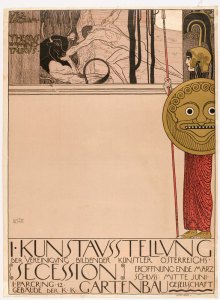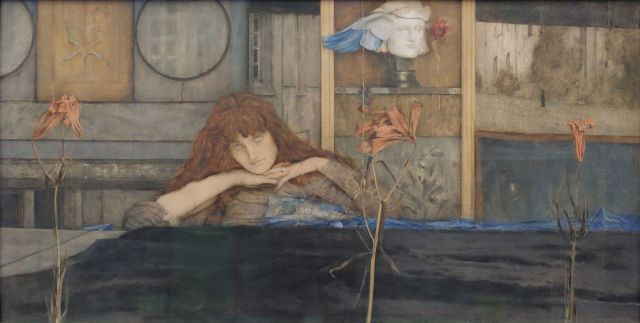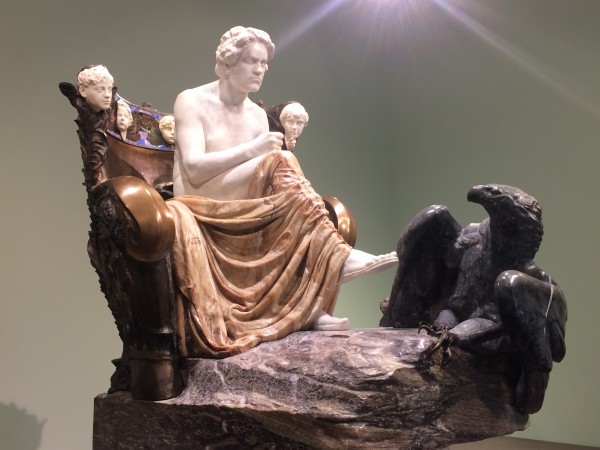In a pile of old newspapers, about to be burned, Jenkins spies a review of the Bosworth Deacon Centenary Exhibition being mounted at the Barnabas Henderson Gallery.
‘… albeit his roots lie in Continental Symbolism, Deacon’s art remains unique in itself. In certain moods he can recall Fernand Khnopff or Max Klinger, the Belgian’s near photographic technique observable in Deacon’s semi-naturalistic treatment of more than one of his favourite renderings of Greek and Roman legend. In his genre pictures, the academic compliances of the Secession School of Vienna are given strong homosexual bias…’ [HSH 226/247]

Poster for Secession I
Gustav Klimt, 1898
color lithograph, 39 x 28 in
Museum of Modern Art, NY
photo from nyarc.org
The Secession School of Vienna was a group of some 20 artists who seceded from the establishment Vienna Künstlerhaus in 1897. Their president and now best known member was Gustav Klimt (Austrian, 1862-1918). The Secessionists worked in multiple media and produced exhibitions, catalogues, and a magazine showing their views on the how art should respond to the new century. In the poster (at left) for their first exhibition, Athena, in red, symbolizes wisdom, and Theseus on the frieze above is batttling against philistinism. The poster was initially censored until Klimt added the tree to hide Theseus’ genitalia.
Fernand Khnopff (Belgian, 1858-1921) was an honorary member of the Secession. He displayed 21 works at the first Secession Exhibition in 1898.

I Lock My Door Upon Myself
Fernand Khnopff, 1891
oil on canvas
Neue Pinakothek, Munich
photo by Yelkrokoyade via Wikimedia Commons
We show I Lock My Door Upon Myself, which shows Khnopff’s debt to the Pre- Raphaelites. He made frequent trips to Britain and was friendly with artists like Hunt, Watts, Burne-Jones, and Dante Gabriel Rossetti. The painting is based on a poem by Christina Rossetti, sister of Dante Gabriel. The third stanza of the poem is
I lock the door upon myself,
And bar them out; but who shall wall
Self from myself, most loathed of all.
Khnopff was a Symbolist, who expected us to see the painting not as simple representation but as a narrative pieced together from its icons, like the dried red lilies. The white bust, which might have appealed to Mr. Deacon’s classical leanings, is of Hypnos, the god of sleep. For more on this painting and its iconography, watch the Khan Academy video on it.

The Sphinx or The Caress
Fernand Khnopff, 1896
oil on canvas, 20 x 59 in
Musées Royaux des Beaux-Arts, Brussels
The Yorck Project via Wikimedia Commons
Jenkins read on in the review: “even Deacon’s sphinxes and chimeras posssessing solely male atrributes.” [HSH 226/247 ] Mr. Deacon would have liked Oedipus (left in The Caress), reminiscent of the androgynous figures in works by Mr. Deacon’s ‘master’, Simeon Solomon, but might not have approved any hint of the feminine in the face of Khnopff’s sphinx. Beethoven (shown below) by Max Klinger (German, 1857-1920 ), bare chested in a classical setting, would also likely get Mr. Deacon’s approval.

Beethoven
Max Klinger, 1902
marble, alabaster, amber, bronze, ivory; lifesize
Museum der bildenden Künste Leipzig
photo by Henning Høholt from Kulturkompasset.com.
Klinger was another honorary member of the Secession. His Beethoven was the center piece of the fourteenth Secession Exhibition (1902), along with a frieze by Klimt. Klinger, like Khnopff, was a Symbolist. Some viewers see the eagle at Beethoven’s feet as an icon for Zeus, indicating that Beethoven is enthroned with the Olympian gods, or while others see the eagle as a symbol for Saint John the Baptist. The Secessionists believed in “spatial” art, so the whole exhibit room was designed as a temple to the deity in the sculpture, but some critics saw only an angry old man, waiting for his turn at a public bath.
Jenkins introduced Mr. Deacon at the beginning of A Buyer’s Market and mixed a fond nostalgia for Deacon with an ironic mockery of his theory and execution of art. Now that the reviewer compared Deacon to better known Symbolists and Secessionists, Jenkins felt “a sense of satisfaction in reading praise of Mr. Deacon… given by a responsible art critic” but was still quite aware of his shortcomings and marvelled that Deacon’s art was having “not so much a Resurrection as a Second Coming.” [HSH 227/248]